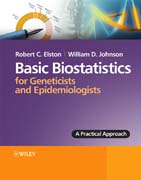
Basic biostatistics for geneticists and epidemiologists: a practical approach
Elston, Robert C.
A revised edition of Essentials of Biostatistics, Basic Biostatistics for Geneticists and Epidemiologists: A Practical Approach uses examples of computer code, practice exercises, and pictorial representations to teach those with little or no statistical background the skills necessary to understand research literature in genetics and epidemiology. Unlike other elementary biostatistics texts, this book explains fundamental concepts without the complications of computational details. With additional access to an accompanying website, this updated text provides graduate students, researchers and practitioners the knowledge necessary to understand research literature. INDICE: Preface. 1 Introduction: the Role and Relevance of Statistics, Genetics and Epidemiology in Medicine. Why Statistics? What Exactly Is (Are) Statistics? Reasons for Understanding Statistics. What Exactly is Genetics? What Exactly is Epidemiology? How Can a Statistician Help Geneticists and Epidemiologists? Disease Prevention versus Disease Therapy. A Few Examples: Genetics, Epidemiology and Statistical Inference. Summary. References. 2. Populations, Samples, and Study Design. The Study of Cause and Effect. Populations, Target Populations, and Study Units. Probability Samples and Randomization. Observational Studies. Family Studies. Experimental Studies. Quasi-Experimental Studies. Summary. Further Reading. Problems. 3. Descriptive Statistics. Why Do We Need Descriptive Statistics? Scales of Measurement. Tables. Graphs. Proportions and Rates. Relative Measures of Disease Frequency. Sensitivity, Specificity, and Predictive Values. Measures of Central Tendency. Measures of Spread or Variabillty. Measures of Shape. Summary. Further Reading. Problems. 4. The Laws of Probability. Definition of Probability. The Probability of Either of Two Events: A or B. The Joint Probability of Two Events: A and B. Examples of Independence, Nonindependence, and Genetic Counseling. Bayes? Theorem. Likelihood Ratio. Summary. Further Reading. Problems. 5. Random Variables and Distributions. Variability and Random Variables. Binomial Distribution. A Note about Symbols. Poisson Distribution. Uniform Distribution. Normal Distribution. Cumulative Distribution Functions. The Standard Normal (Gaussian) Distribution. Summary. Further Reading. Problems. 6. Estimates and Confidence Limits. Estimates and Estimators. Notation for Population Parameters, Sample Estimates, and Sample Estimators. Properties of Estimators. Maximum Likelihood. Estimating Intervals. Distribution of the Sample Mean. Confidence Limits. Summary. Problems. 7. Significance Tests and Tests of Hypotheses. Principle of Significance Testing. Principle of Hypothesis Testing. Testing a Population Mean. One-Sided versus Two-SidedTests. Testing a Proportion. Testing the Equality of Two Variances. Testing the Equality of Two Means. Testing the Equality of Two Medians. Validity and Power. Summary. Further Reading. Problems. 8. Likelihood Ratios, Bayesian Methods and Multiple Hypotheses. Likelihood Ratios. Bayesian Methods. Bayes Factors.Bayesian Estimates and Credible Intervals. The Multiple Testing Problem. Summary. Problems. 9. The Many Uses of Chi-Square. The Chi-Square Distribution. Goodness-of-Fit Tests. Contingency Tables. Inference About the Variance. Combining p-Values. Likelihood Ratio Tests. Summary. Further Reading. Problems. 10. Correlation and Regression. Simple Linear Regression. The Straight-Line Relationship When There is Inherent Variability. Correlation. Spearmans Rank Correlation. Multiple Regression. Multiple Correlation and Partial Correlation. Regression toward the Mean. Summary. Further Reading. Problems. 11. Analysis of Variance and Linear Models. Multiple Treatment Groups. Completely Randomized Design with a Single Classification of Treatment Groups. Data with Multiple Classifications. Analysis of Covariance. Assumptions Associated with the Analysis of Variance. Summary. Further Reading. Problems. 12. Some Specialized Techniques.Multivariate Analysis. Discriminant Analysis. Logistic Regression. Analysis of Survival Times. Estimating Survival Curves. Permutation Tests. Resampling Methods. Summary. References. Further Reading. Problems. 13. Guides to a Critical Evaluation of Published Reports. The Research Hypothesis. Variables Studied.The Study Design. Sample Size. Completeness of the Data. Appropriate Descriptive Statistics. Appropriate Statistical Methods for Inferences. Logic of the Conclusions. Meta-analysis. Summary. Further Reading. Problems. Epilogue. Review Problems. Answers. Appendix. Index.
- ISBN: 978-0-470-02489-8
- Editorial: John Wiley & Sons
- Encuadernacion: Cartoné
- Páginas: 392
- Fecha Publicación: 17/10/2008
- Nº Volúmenes: 1
- Idioma: Inglés
